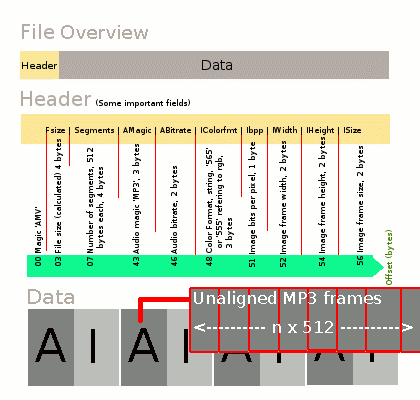MTV
- Extension: mtv (or amv)
- Samples: http://samples.mplayerhq.hu/mtv/
MTV video origin and history
MTV is file format supposedly created to allow video playback capabilities on inexpensive Chinese-made portable MP4 players without increasing the cost of those players with the license royalties (and more processor power). These Chinese MP4/MTV Player (sold as "MP4 Player" or "PMP", for Personal Media Player) are flash-based digital audio players, mostly manufactured in China and capable of displaying images, videos, and text files. Although commonly called MP4 players, are unable to play true MP4 (MPEG-4 AVC H.264) formated videos and are limited to proprietary formats such as this one and AMV.
MTV File Format
The format operates by displaying a series of raw uncompressed rgb565/555 image frames while playing MP3 audio but as the files are of low resolution and frame rate, sizes are comparable to MPEG-1 or MPEG-2. (in a bytes-per-minute sense). Encoding and decoding are less processor-intensive than other contemporary formats, as in fact very little "encoding" is actually done.
The MTV format consists of a 512 byte file header, followed by alternating audio and image blocks. Audio frame data is not necessarily aligned on block boundaries and each one of them has from 1 to n subblocks of 512 bytes each with 'n' remaining constant through the entire file/stream. The first 12 bytes of each audio subblock is padding data and is always set to 0. Image data, on the other hand, is perfectly contained in each image data block, each one representing an entire frame.
During decoding of the video stream, the audio frames are passed to the MP3 hardware decoder, while the memory pointer of the display hardware is simply adjusted to the next raw image within the video stream. While this concept does not require additional * hardware for the decoding process, it leads to huge memory requirements as no compression is applied to the image frame data.

|
|---|
MTV vs. [MPEG-2] (using typical values/approximations):
Note! These MTV/AMV calculations are based on 30 minutes at 128 x 96 pixels, 12 frames/s, 22050 samples/s mono sound : 80 MB (approx) The audio is 22050 samples/s, mono, MP3(?) - a safe guess would be a maximum of 10 MB being audio, yielding 70 MB for video, or approximately 40,000 bytes per second.
| file | Approx. data rate | Resolution (pixels) | Frame rate | Pixels per second | Pixels per byte |
|---|---|---|---|---|---|
| AMV | 40,000 B/s | 128 x 96 = 12,288 | 12 fps | 147,456 | ~3.5 |
| DVD (MPEG-2 PAL) | > 1,000,000 B/s | 704 x 576 = ~400,000 | 25 fps | ~10,000,000 | ~10 |
Encoding and transcoding/conversion software utilities
The software available in April 2006 allows screen sizes of 94x64, 128x96 and 128x128 pixels, typically set to frame rates of 8, 12 and 16 frames per second (described as "low","medium" and "high"), which fits reasonably well on 1.2 to 1.5+ inch screens. By editing configuration files the range of frame rates handled by the encoder can be expanded to 8-24 (in 1fps increments), though using alternate framerates may cause problems if the player is not designed for those.
- www.mympxplayer.org - MP4 resource site and support forum, with MTV conversion/transcoding tools and utilies, (plus sample downloads)
- MTV/AMV encoding tips
Software players that support MTV and AMV playback
Hardware players that support MTV and AMV playback
Chinese-made portable MP3 players, also known as S1 MP3 Players.
External Links
- "Chinese-made portable MP3 player" article on wikipedia.org
- "S1 MP3 Player" article on wikipedia.org
- www.mympxplayer.org - MP4 resource site and support forum, MTV conversion/transcoding tools and utilies, plus sample downloads
- MTV Video topic-thread on moviecodec.com forum
- MP4 Player Search - Community powered and driven
- MP4 Nation Knowledge Base: Support and tips on MP4 Players
- An introduction to MP4 players, what they do, what you can do to them and a review
- Recovering dead players and other software
- MP4 Forums on S1MP3.org
- MTV Video Forum
- (A very negative) video-review of one of these MP4-Player on Youtube